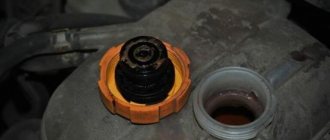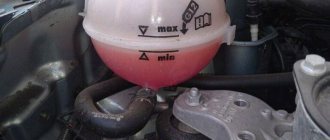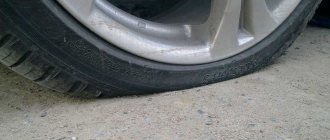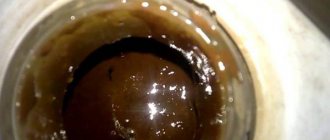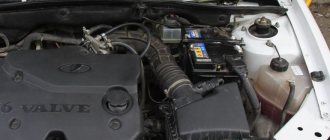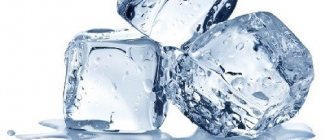Most of the coolants on the market today are brightly colored - green, blue, yellow, red, etc. Many of them come with fluorescent additives. With the help of this coloring, a variety of problems are solved - both marketing and practical. Eye-catching colors, for example, help to quickly detect a leak if it occurs. Over time, the shade may change, but only slightly, and atypical deviations in color indicate problems or low quality of the liquid. If the antifreeze turns brown, this is a reason to check the performance of the cooling system components, as well as the quality of the mixture itself.
Causes of brown tint
During operation, antifreeze experiences thermal loads, enters into chemical interactions, and operates in high-pressure modes. The working life of the base composition and coolant additives is spent on ensuring favorable conditions for the functioning of the engine cooling system, as well as on increasing the wear resistance of its components. Over time and under the influence of external factors, the physicochemical properties of the refrigerant change. In some cases, this is accompanied by a brown tint.
Expiration date
. Like any other technical fluid used in a car, antifreeze has a certain shelf life. In the most general case, it is generally accepted that the coolant maintains performance characteristics for 50,000 km. But you should focus primarily on the manufacturer’s recommendations, as well as the make of the car, operating conditions, and age of the vehicle. By the time the coolant expires, its color may change from its original color - green, blue, yellow or any other - to brown. This color indicates that the additives no longer cope with their functions and precipitate, which gives the liquid a rusty tint.
Engine overheating and coolant boiling
. Antifreeze can boil due to poor-quality composition of the liquid itself or as a result of malfunctions of individual components of the cooling system and power unit. The engine then overheats and the coolant turns brown and requires replacement. Overheating of the engine can occur due to insufficient coolant: in this case, the cooling of the cylinder head (the hottest part of the internal combustion engine) worsens, and subsequently the fluid circulation stops altogether. An overheated engine should be sent for diagnostics, as the consequences can be quite serious.
Destruction of rubber pipes
. If the coolant is used longer than the period prescribed by the manufacturer, it begins to destroy the rubber pipes of the cooling system. As a result, rubber particles get into the antifreeze, causing it to darken.
Oxidation of metal parts of the cooling system
. Constant contact with liquid media can cause pockets of corrosion on the surface of metal parts. The likelihood of rust increases as the coolant approaches its expiration date. That is, the older the antifreeze, the worse its additives cope with its protective functions. Obviously, this fluid requires replacement.
Mixing with oil
. Contact of coolant with engine oil can occur due to damage to the cylinder head gasket or defects in the cylinder head and block (for example, cracks on their surface). It is highly not recommended to operate an engine with such a malfunction. A sign of mixing antifreeze with a lubricant will be a vaporous exhaust, and the liquid itself will change not only the color, but also the consistency - it will become thicker and more viscous.
Using water as coolant
. You can add ordinary water to the cooling system only in a situation where there is no other choice. For example, when there was a fluid leak on the road that you fixed with a sealant. After this, you need to add coolant to the required level, but you don’t have antifreeze with you. In this case, they usually add water, since it is better to have such a refrigerant than to drive without it at all or with an insufficient amount of liquid. If this compound is not replaced soon, it is guaranteed to turn brown as the metal parts begin to rust.
Using chemicals to eliminate leaks
. The retail chain today offers many antifreeze additives designed to eliminate leaks, clean the system, etc. Such additives work with varying degrees of effectiveness, but they can change the color of the coolant. If, after using chemicals, the coolant turns brown, there is a possibility that the properties of the coolant have changed along with the color. To save yourself from problems with the cooling system on the road, it is better to replace such a mixture.
Failure to comply with operating instructions
. Regardless of the reason why the antifreeze turned brown, it needs to be changed, and it is better not to delay it. But errors during replacement can lead to the fact that after a few weeks the new fluid also changes color. To prevent this from happening, you must:
- first eliminate the reason why the previous liquid became unusable (if the color change is not associated with its natural production);
- Before filling in a new cooler, flush the entire cooling system to eliminate the remnants of the old one. Otherwise, they may begin to mix with the new one and worsen its properties.
You may be interested in: Why did the antifreeze in the expansion tank become dark and cloudy?
Why did antifreeze turn red?
The antifreeze in the tank has turned brown.
Sometimes the antifreeze becomes reddish over time. The reason for this may be the intensive operation of the engine, which leads to prolonged high temperature loads. For example, if the car very often gets into traffic jams or moves for a long time at maximum speed. That is, the antifreeze cannot cope with the load and begins to acquire a red color. This color, by the way, is obtained as a result of the dissolution of iron particles from cylinder blocks.
In the worst case scenario, if the antifreeze loses its properties, the engine may fail.
The reason for this process may be a low-quality or outdated antifreeze formulation, which simply cannot cope with the loads on the car engine. The fact is that the modern design of cooling systems in cars (even in modern VAZs) is made in such a way that excessive pressure often occurs in the antifreeze, and the boiling point rises to one hundred twenty or one hundred thirty degrees. And at such high temperatures, corrosion inhibitors cease to provide the necessary protection. From this we can conclude that antifreeze, which was produced in the Soviet Union, is not always suitable for modern vehicles.
How to solve a problem
it is important! If the antifreeze has darkened or acquired a rusty tint, it definitely needs to be changed. A change in coolant color indicates that the coolant has lost its ability to protect the internal surfaces of the system from harmful influences and ensure normal engine operation. It is equally important to establish the reason why the refrigerant has changed color. If it is wear and has expired, it will be enough to flush the cooling system and add new high-quality fluid. If the cause is related to a malfunction of one of the vehicle components, it must first be eliminated.
You need to check:
- pipes and other rubber elements;
- cylinder head gasket;
- heat exchanger
If you have symptoms of an overheating engine, you should conduct a thoughtful diagnosis to find out why it is overheating and eliminate any possible problems.
Replacing the cylinder head gasket
. If, as a result of the diagnosis, it was determined that the antifreeze changed color to brown and turned into an oil emulsion due to damage to the cylinder head gasket, the car is sent for repair. The machine cannot be operated until the seal has been replaced. This type of work is performed in a car service center or independently. If you intend to replace the gasket between the cylinder head and the cylinder block with your own hands, you need to do the following:
- buy a new part (by VIN code);
- dismantle attachments - filters, pipes, etc.;
- remove the cylinder head cover;
- unscrew all cylinder head mounting bolts;
- remove the cylinder head;
- Replace the seal and reassemble in reverse order.
Cleaning the cooling system
. If before replacing rusted antifreeze it is necessary to flush the radiator and other elements of the cooling system, this is done as follows:
- The machine is installed on a flat surface. If the engine is hot, let it cool;
- open and secure the hood, place containers under the radiator and engine to collect old fluid;
- unscrew the drain plugs of the engine and heat exchanger, pour the waste material into a previously prepared container;
- tighten the plugs and pour distilled water into the system. To more effectively wash internal surfaces, add citric acid or special chemicals to the water, which are offered in a wide range in the retail chain;
- start the engine for 15-20 minutes, then turn it off and repeat the procedure after 2-3 hours;
- if acid or additives were used, perform a final rinse with distilled water, after which new antifreeze is poured into the system.
Eliminating the causes of boiling
. In cases where the refrigerant rusts after boiling, in addition to replacing it, you need to figure out why the liquid overheated in order to prevent this from happening in the future. You should check such parts and assemblies as:
- thermostat. If it works intermittently, the large circulation circuit may not open and the fluid moves only in a small circle;
- expansion tank and radiator caps. Their malfunction can lead to depressurization, a decrease in pressure and, as a result, a decrease in the boiling point of antifreeze;
- temperature sensors. If they do not work correctly, the coolant temperature will be determined incorrectly, which will lead to its overheating;
- electric fan motor, which is responsible for cooling the radiator;
- water pump. It is important to prevent excessive wear of pump parts;
- cooling radiator. The channels through which the liquid flows become clogged with deposits, become narrower, and the refrigerant flowing through them overheats.
What to do?
If the color of antifreeze changes, it is simply necessary to eliminate the problem as soon as possible. This is especially important when an oil emulsion appears in the system. In this case, the engine must not be started until the fault is eliminated. Usually the cause is a blown engine head gasket.
If rust appears, you should simply replace the antifreeze. But, before filling in new coolant, it is necessary to flush the system, otherwise the problem will recur.
conclusions
. Problems with the cooling system are not uncommon. In this regard, the question of why antifreeze (antifreeze) turned rusty or brown is not rare enough. This deficiency occurs quite often, so you need to know how to eliminate it.
Choosing quality antifreeze
When choosing a coolant, it would be correct to focus not on the shade, but on the composition of the mixture and the brand’s reputation. Choose high-quality mixtures that are protected from counterfeiting and suitable for your car. SINTEC Multifreeze is the optimal solution, universal and suitable for different types of loads and engines. Multifreeze combines the advantages of both types of coolant, as it contains both inorganic additives and carboxylic acids. Can be used for a long time and does not turn brown. Its innovative properties make it possible to operate for a long time without deteriorating.
#Trouble-shooting
Consequences of failure to replace
As it is used, the coolant loses its properties and ceases to be effective. Its further circulation within the system brings more problems than benefits.
Due to old and worn-out coolant, the cooling system is subjected to very serious loads, and the engine overheats. This leads to all sorts of malfunctions, some of which may well result in a major overhaul.
If you do not change the coolant, you will simply destroy your own engine with your own hands.
You may also be interested
Why antifreeze leaked, causes of leakage and what to do
An insufficient level of antifreeze leads to overheating of components and parts and disruption of the optimal temperature regime. Therefore, if a leak is detected, the problem should be addressed immediately. Otherwise, this can lead to serious consequences for the engine.
Why does antifreeze thicken and turn into mush?
Many drivers, sooner or later, may encounter a situation where they see that the antifreeze has thickened or turned into porridge, that is, it has acquired an unusual consistency of jelly or thick yogurt. In order to protect your car from serious repairs, and yourself from an accident, it is better to fix this breakdown as soon as possible.
Is it possible not to change the coolant and continue driving?
All types of coolant have a certain service life. After some time, the antifreeze will lose its characteristics. What does this lead to? That's right, to engine overheating! What does overheating lead to? In the best case, engine power will seriously drop and oil consumption will increase. At worst, it will simply jam and you will not be able to continue moving.
If antifreeze (antifreeze) darkens, it is better to solve the problem immediately, since in the future this may lead to more serious difficulties that require significant financial investments. Change the fluid in your car's engine cooling system in a timely manner and remember that prevention is always cheaper than repairs!
Antifreeze is a special coolant used in a car. The main function of this fluid is to regulate the temperature of the engine during operation. Antifreeze is usually made in blue color. But it happens that certain varieties of this coolant are produced in a different color. For example, the Tosol - 65 brand is red.
Lada Granta 2016, engine Gasoline 1.6 liter., 87 hp, Front drive, Manual — observation
Comments 43
Topped up with incompatible antifreeze, the simplest and most common thing. The truth is, no one admits... It kind of just became that way.
99% oil or overheating, as they suggest
It's definitely not oil
if there was scorched antifreeze, it would naturally float up immediately, and not after 2 years) overheating still remains, but I don’t know how the color of the liquid changes in this case. I know that when it overheats, 99% of the time it leads to the head and the gasket suffers. But our gaskets are metal, it’s mainly the head that suffers. What engine?
if there was scorched antifreeze, it would naturally float up immediately, and not after 2 years) overheating still remains, but I don’t know how the color of the liquid changes in this case. I know that when it overheats, 99% of the time it leads to the head and the gasket suffers. But our gaskets are metal, it’s mainly the head that suffers. What engine?
There is no smell of oil in the barrel,
99% oil or overheating, as they suggest
There can't be overheating either.
So replace the fluid and everything will be ok. since everything is ok
99% oil or overheating, as they suggest
Nope). This can happen when additives exhaust their resource and corrosion begins!)
Any motorist knows that it is periodically necessary to check the level of consumables and, if necessary, replace working fluids. In particular, this applies to antifreeze, which has serious functions. And quite often, motorists are faced with a situation where the color of antifreeze, for inexplicable reasons, begins to change color. What this could mean and why this happens will be discussed in more detail in this material.
When to be wary
- The coolant darkened greatly and acquired a shade that it could not achieve naturally.
- You can see rust in the liquid, the color itself looks rusty.
- The change in shade is combined with inclusions of oil or other liquid in the antifreeze, which should not be in the cooling system during normal operation.
If a change in color leads to the development of an unpleasant odor, the appearance of smoke or other alarming signs, it is necessary to urgently carry out repairs: this may indicate serious deviations in the operation of the systems.
There are several nuances that will help increase the resource of “Antifreeze” or antifreeze:
- The first thing to remember is that the consumables should always be of the highest quality. If you do not want to face the problem of darkened Antifreeze, then you cannot use liquid purchased from merchants on the side of the road or in unverified stores. If you are using original products, pay attention to checking the place of production. Sometimes high-quality European antifreezes are made in China or Mongolia, which, of course, indicates their poor quality.
- The performance characteristics of the fluid should also be given attention. You should know which specific antifreeze your car manufacturer recommends using. There are certain additives, the use of which is permitted or not permitted by the machine manufacturer. Therefore, such nuances should be taken into account.
- The cooling system should always be flushed before replacing consumables. Regardless of whether obvious deposits are visible in the expansion tank or not. Flushing will always help get rid of sediments that may not be visible to the naked eye. In any case, even after a year of operation of the coolant, there will be deposits in the system pipes, let alone three to four years of using the refrigerant.
Replaced it after a couple of weeks, dark again
This also happens, it seems like I drained the old fluid and poured in a new clean one, but a couple of weeks passed and it’s dark again. WHY? YES it's simple. You didn't flush the system, THIS IS A GREAT MISTAKE!
When the antifreeze is new, it begins to wash away all the old plaque from the walls and pipes inside. It is because of this that even new liquid will quickly turn back into brown.
Therefore, we remember - be sure to rinse.
Now we are watching the video version.
I’ll end here, I think my article and video were useful to you. Sincerely yours, AUTOBLOGGER.
( 49 votes, average: 4.51 out of 5)
Similar news
Is it possible to mix antifreeze and antifreeze (red, green, blue). TO.
Protective mesh for the radiator grille. To bet or not?
Is it possible to pour water instead of antifreeze: winter - summer
Antifreeze has changed color to rusty: what to do and what is the reason
- Main causes of failure
- Expiration of service life
- Engine overheating and antifreeze boiling
- Oxidation of the metal walls inside the tank
- Wear of rubber pipes
- Using ordinary water to cool the system
- Violation of the tightness of the cylinder head gasket and heat exchanger
- Means for eliminating radiator leaks
- Ways to solve the problem
- Conclusion
The car owner is required to periodically check the coolant level to prevent overheating of the car and wear of parts. In addition, the density and color of the antifreeze matter. If the antifreeze suddenly turns rusty in color, it is important to find out what is causing the problem. Timely diagnosis will allow you to avoid costly repairs.

